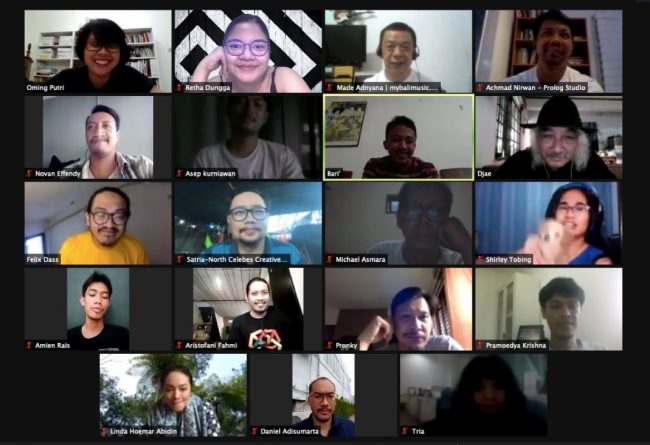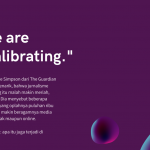2017 jadi tahun kelabu bagi pencinta ulasan musik di Indonesia, karena majalah Rolling Stone dan Hai berhenti cetak. Tamatnya kedua majalah ini menambah panjang daftar media musik yang gulung tikar, menyusul Aktuil (1986) dan Trax Magazine (2016). Sementara itu, di skena lokal, penulis dan jurnalis memanfaatkan teknologi digital untuk menghidupi media musik alternatif.
Musik memang bukan untuk sekadar didengar. Dengan menulis soal musik di berbagai platform media, musisi, jurnalis, dan penulis dapat melakukan refleksi atas perkembangan ekosistem musik. Peta ekosistem musik dalam studi Dina Dellyana, Fikri Hardiansyah, Adib Hidayat, dan Widhi Asmoro tentang Rencana Pengembangan Industri Musik Nasional 2015 – 2019 menunjukkan, media musik—baik arus utama maupun alternatif—turut berperan mendorong apresiasi publik terhadap musik.
Media musik alternatif umumnya bersifat independen dari kepentingan politik redaksi media massa arus utama, sehingga gagasan musisi lokal terwadahi.
Media yang umumnya digagas musisi, jurnalis, dan penulis lokal itu punya keunikan mampu mempertemukan asosiasi, komunitas, dan musisi lokal. Ekspresi dan gagasan musisi lokal, yang lazimnya tak terfasilitasi oleh media arus utama, mendapatkan ruangnya di media musik alternatif. Sehingga, keberadaannya berkontribusi memperkaya lansekap ekosistem musik di Indonesia.
Bagaimanapun, mempertahankan media musik lokal tak semudah memetik senar gitar. Di tengah kendala finansial, Achmad Nirwan (Prolog Studio, Makassar) dan I Made Adnyana (mybalimusic.com, Bali) berbagi cerita perjuangan mengelola media musik lokal. Mereka menyampaikan kisahnya dalam Temu Tamu Anggota Musik Koalisi Seni, forum internal anggota Koalisi Seni, pada Selasa, 17 Oktober 2020.
Sejak 2011, Nirwan mengamati perkembangan rubrik hiburan di berbagai media cetak arus utama. Ia menyadari sorotan media turut mengangkat kiprah para musisi Makassar. Namun baginya, musik tak mendapat cukup ruang karena harus bersaing dengan jenis seni dan isu lainnya, seperti pariwisata. “Media musik lokal seperti zine diperlukan untuk menyorot musisi di skena independen, karena umumnya media massa arus utama hanya meliput musisi pop,” kata Nirwan.
Minimnya perhatian media massa pada musisi lokal turut dirasakan I Made Adnyana, jurnalis senior asal Bali. Menurutnya, media massa arus utama bergantung pada pemasukan dari iklan, yang umumnya digaet liputan isu ekonomi atau politik terkini. Hal ini membuat ruang untuk musik dan seni pada umumnya dianggap kurang menguntungkan. Ruang musik dan seni pun makin sempit. Setelah keluar dari Bali Post dan Denpasar Post, ia tergerak mendirikan media musik alternatif bernama Majalah Intro, yang kemudian berubah menjadi Bali Music Magazine. Namun, seiring berjalannya waktu, Adnyana mengakui media yang ia dirikan dengan ongkos sendiri itu perlahan mengalami krisis finansial sehingga hijrah ke bentuk website, mybalimusic.com.
“Idealis boleh, tapi kalau mau survive (bertahan) harus banyak kompromi, karena ada pergeseran besar dalam media. Saya tidak melihat untungnya di mana. Passion saya di musik. Beruntung media online lebih fleksibel, kalau cetak berurusan dengan deadline,” ucapnya.
Platform daring sebagai alternatif media musik lokal juga dimanfaatkan Nirwan dan kawan-kawannya yang tergabung di Prolog Studio, ruang kreatif di Makassar. Mereka telah menerbitkan Zine Vonis yang memuat 20 lagu terbaik Makassar 2008–2012, Majalah Opium yang mengangkat musik dan budaya pop, hingga Revius tentang kritik musik. Kendala finansial membuat Nirwan mengalihkan zine yang semula cetak ke platform daring. “Kami belajar untuk menggali apa saja yang menarik untuk dibahas. Meski ada masalah finansial, tapi teknologi yang dinamis semoga membuat kami tetap semangat untuk bertahan,” ujarnya.

Diskusi yang dihadiri 12 anggota Koalisi Seni ini berlangsung interaktif, mengungkap pengalaman mengelola media alternatif di daerah masing-masing. Seperti Djae, asal Bandung yang ingin memindahkan majalah musiknya, Dot Beg World Jazz ke dalam format digital. “Seperti apa kira-kira saran agar (format digital) ini berkelanjutan?” Tanya Djae.
Adnyana menanggapi, kesempatan media musik alternatif dapat berkembang luas dan berkelanjutan asal para pegiatnya berpikiran terbuka, punya kemauan terus belajar, serta ulet menjalin koneksi dengan pegiat musik di daerah-daerah lain sebagai upaya memperluas pandangan dan pengetahuan musik. Nirwan menambahkan, semangat mendirikan media alternatif juga turut membuka peluang eksplorasi dari bentuk cetak ke website hingga meluas ke Youtube dan Podcast, seperti pengalamannya mengelola media musik alternatif “Siaran Pemancar” sejak 2017.
Dengan memanfaatkan berbagai teknologi digital, Nirwan dan Made Adnyana melihat ada harapan bagi media musik alternatif untuk terus bertahan, mewadahi suara-suara musisi lokal di tengah gempuran hegemoni media arus utama. (Dian Putri)



